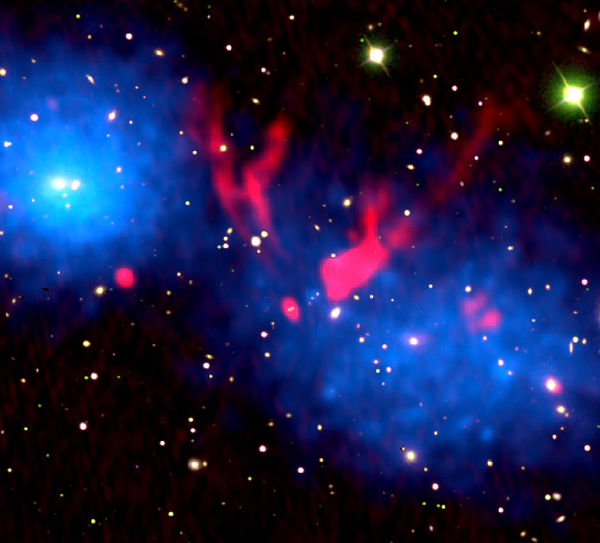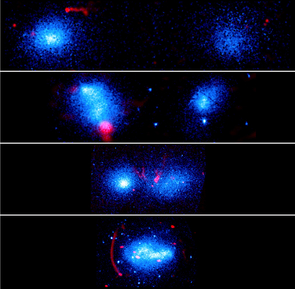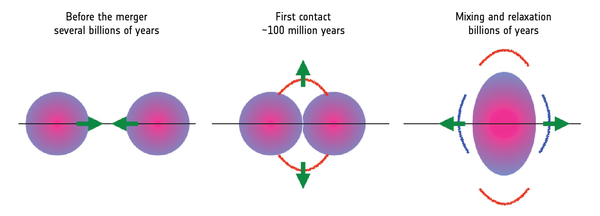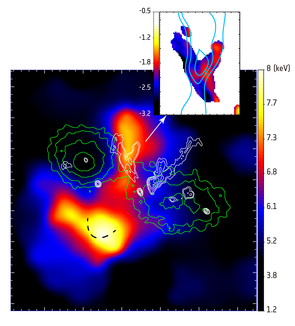X-rays reveal how cosmic giants meet
24 June 2019
Scientists have uncovered an extremely powerful shock wave in a distant part of the Universe where two massive galaxy clusters appear to come into first contact ahead of merging. The study is based on data from several astronomical facilities, including ESA's XMM-Newton X-ray space observatory. |
| Merging galaxy clusters at first contact. Credit: NASA/CXC (X-rays); SDSS (optical); GMRT (radio); Liyi Gu et al. 2019 |
According to Liyi Gu, an astronomer from RIKEN High Energy Astrophysics Laboratory in Japan and the Netherlands Institute for Space Research, who is the lead author of a paper published today in Nature Astronomy, the observations capture the unique moment when the two clusters touch each other for the very first time – something that has never been observed before.
The clusters, called 1E2216 and 1E2215, are located over one billion light years away from the Earth and have been drawn towards each other by gravity for billions of years. Their first contact, indicated by the new data, marks the beginning of a dramatic and lengthy process that will completely mix the clusters up and combine them into one.
"Collisions between galaxy clusters are the most energetic events in the Universe since the Big Bang," said Liyi. "The shocks that arise during the merger are probably the most important particle accelerator in the Universe, releasing a huge amount of heat, radiation and high-energy cosmic rays."
 |
| Sequence of merging galaxy clusters. Credit: click image for credit details. |
Clusters of galaxies are the largest known objects in the cosmos bound by gravity, and can consist of hundreds of galaxies, each containing billions of stars or more. Interspersed between a cluster's galaxies are huge amounts of hot, X-ray emitting gas, and even larger amounts of the invisible dark matter.
These enormous cosmic objects are thought to form gradually, starting first with individual galaxies encountering each other due to the effects of gravity. The process continues with the formation of smaller groups, which then merge into bigger and bigger clusters. While the first touch, the so-called pre-merger phase, lasts for a relatively short period of time – around 100 million years – the entire merging process takes billions of years to complete.
Liyi and collaborators around the world gathered about 40 hours of observations with ESA's XMM-Newton in 2017 and another 40 hours with NASA's Chandra X-ray telescope in 2018. These observations were combined with 2012 data from JAXA's now decommissioned Suzaku satellite and with radio data from two ground-based telescopes located in Europe and India.
The scientists think that the data reveal a pre-merger shock caused by the first contact between the two clusters.
 |
| Shocks during galaxy cluster merger. Credit: Courtesy of H. Akamatsu (SRON) |
In the observations, they could distinguish two very hot gas halos with temperatures in excess of 50 million degrees Celsius, each associated with either cluster, and connected by a bridge of even hotter gas.
"This gas bridge is shock-heated: on the two sides you can see a shock front propagating from the inside out along the equatorial plane of the merger," explained Liyi. "The bridge was created by the merger itself. As the two clusters are getting closer, at some point they start getting connected."
 |
| Temperature distribution of merging galaxy clusters IE2216 and IE2215. Credit: ESA/XMM-Newton; GMRT; Liyi Gu et al. 2019 |
Liyi added that it was somewhat surprising to see the shock wave propagating outwards along the equatorial plane, as most shocks found in merging galaxy clusters usually propagate along the vertical axis of the merger. However, theoretical models and numerical simulations do predict that a similar phenomenon might occur during the pre-merger phase.
"The equatorial shock can be explained simply by a very strong compression along the merger axis," said Liyi.
In particular, XMM-Newton enabled the scientists to calculate the temperature distribution of hot gas within the two clusters, as well as the extremely high temperature in the shock region, reaching up to 100 million degrees Celsius.
"From the XMM-Newton data, we could estimate the shock speed and the total dynamic energy of the system, including its pressure," said Liyi.
The team is planning to keep monitoring this cosmic encounter with XMM-Newton and Chandra.
In coming years, XMM-Newton can be used to identify more cluster mergers like this one via dedicated observations of carefully selected portions of the sky. Next-generation X-ray observatories, such as the Japanese-led XRISM and ESA's Athena missions, will enable astronomers to learn in even greater detail what is happening during these gigantic collisions.
"We have been very lucky to have seen this first encounter between the two clusters," said co-author Jelle Kaastra from the Netherlands Institute for Space Research.
"Usually, we can see galaxy clusters getting closer to each other or already in the process of merging. With the next generation of X-ray telescopes, such as XRISM and Athena, we will be able not only to see more details of this particular merger but also find many more systems that are in different merging phases."
XRISM, a collaboration between JAXA and NASA including ESA participation, is scheduled to launch in 2021. Athena, part of ESA's Cosmic Vision programme, is expected to launch in 2031, and will carry instruments one hundred times more sensitive than those aboard Chandra and XMM-Newton.
Galaxy cluster mergers are among the most important processes that shape the structure of the Universe on very large scales. Yet, these giant collisions are poorly understood. With the facilities of the coming decades, scientists will be able to observe more such events at various stages and eventually piece together a complete 'movie' of the merging of galaxy clusters.
"Galaxy cluster mergers are difficult to observe because the timescales involved are so long," said Norbert Schartel, XMM-Newton project scientist at ESA.
"It will take a long time to fully understand these processes. We are just getting started by collecting data about mergers at different stages, and it is exciting that XMM-Newton could help capture the beginning of such a clash."
Notes for editors
The results described here are reported in "Observations of a Pre-Merger Shock in Colliding Clusters of Galaxies" by Liyi Gu et al., published in Nature Astronomy.
The study is based on X-ray data from ESA's XMM-Newton, NASA's Chandra X-ray telescope and JAXA's Suzaku satellite, along with radio-wave observations from the Low-Frequency Array (LOFAR), located in the Netherlands and other European countries, and from the Giant Metrewave Radio Telescope, located in India.
The team involves scientists based in Japan, the Netherlands, Australia, Germany, Hungary, the UK, India and South Africa.
For more information, please contact:
Liyi Gu
RIKEN High Energy Astrophysics Laboratory, Japan
SRON – Netherlands Institute for Space Research
Utrecht, The Netherlands
Email: L.Gu![]() sron.nl
sron.nl
Jelle S. Kaastra
SRON – Netherlands Institute for Space Research
Utrecht, The Netherlands
Email: J.S.Kaastra![]() sron.nl
sron.nl
Norbert Schartel
XMM-Newton Project Scientist
European Space Agency
Email: norbert.schartel![]() esa.int
esa.int




